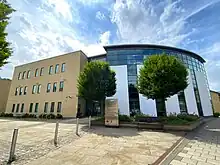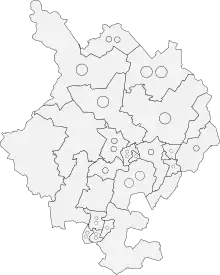Huntingdonshire District Council | |
|---|---|
 | |
| Type | |
| Type | |
| Leadership | |
| Structure | |
| Seats | 52 councillors |
Political groups | Administration (31)
Opposition (21)
|
| Elections | |
| Plurality-at-large and first-past-the-post | |
Last election | 5 May 2022 |
Next election | 2026 |
| Meeting place | |
 | |
| Pathfinder House, St Mary's Street, Huntingdon, PE29 3TN | |
| Website | |
| huntingdonshire | |

Huntingdonshire District Council is the local authority for the district of Huntingdonshire in Cambridgeshire, England. The council is based in the town of Huntingdon. The district also includes the towns of Godmanchester, Ramsey, St Ives and St Neots and surrounding rural areas. The district covers almost the same area as the historic county of Huntingdonshire, which had been abolished for administrative purposes in 1965, with some differences to the northern boundary with Peterborough.
Since 2017 the district has been a constituent member of the Cambridgeshire and Peterborough Combined Authority, led by the directly-elected Mayor of Cambridgeshire and Peterborough.[2]
The neighbouring districts are Peterborough, Fenland, East Cambridgeshire, South Cambridgeshire, Central Bedfordshire, Bedford, and North Northamptonshire.
History
The district was formed on 1 April 1974 under the Local Government Act 1972. The new district covered the area of eight former districts, which were all abolished at the same time:[3]
- Huntingdon and Godmanchester Municipal Borough
- Huntingdon Rural District
- Norman Cross Rural District (except parts within the designated area for Peterborough New Town)
- Ramsey Urban District
- St Ives Municipal Borough
- St Ives Rural District
- St Neots Rural District
- St Neots Urban District
These eight districts had constituted the county of Huntingdonshire until 1965 when it had merged with the neighbouring Soke of Peterborough to form the short-lived county of Huntingdon and Peterborough. As part of the 1974 reforms the area became part of an enlarged Cambridgeshire. The new district was initially named Huntingdon after the former county town.[4] The council changed the district's name from Huntingdon to Huntingdonshire in 1984.[5]
Governance
Huntingdonshire District Council provides district-level services. County-level services are provided by Cambridgeshire County Council. The whole district is also covered by civil parishes, which form a third tier of local government.[6]
Political control
The council has been under no overall control since the 2022 election, being led by a coalition of the Liberal Democrats, Labour, Greens and independent councillors.
The first election to the council was held in 1973, initially operating as a shadow authority alongside the outgoing authorities until the new arrangements came into effect on 1 April 1974. Political control of the council since 1974 has been as follows:[7][8]
| Party in control | Years | |
|---|---|---|
| No overall control | 1974–1976 | |
| Conservative | 1976–2022 | |
| No overall control | 2022–present | |
Leadership
The leaders of the council since 2001 have been:
| Councillor | Party | From | To | |
|---|---|---|---|---|
| Derek Holley[9] | Conservative | 2001 | 7 Dec 2005 | |
| Ian Bates[10] | Conservative | 7 Dec 2005 | May 2011 | |
| Jason Ablewhite[11] | Conservative | 18 May 2011 | May 2016 | |
| Robin Howe[12] | Conservative | 18 May 2016 | 26 Jul 2017 | |
| Graham Bull[13] | Conservative | 26 Jul 2017 | 4 Dec 2019 | |
| Ryan Fuller[14] | Conservative | 4 Dec 2019 | 8 May 2022 | |
| Sarah Conboy[15] | Liberal Democrats | 18 May 2022 | ||
Composition
The council consists of 52 councillors, representing 26 electoral wards. There is currently no party with a majority on the council. Since the elections of 2022 the council has been governed by a coalition of the Liberal Democrats, Independents, Labour, and Greens.[16]
Following the 2022 election, the council's composition was:[17]
| Party | Councillors | Change (from 2018 election) | |
|---|---|---|---|
| Conservative | 22 | −8 | |
| Liberal Democrats | 10 | +3 | |
| Independent | 11 | +6 | |
| Labour | 4 | n/c | |
| St Neots Independent Group | 4 | −2 | |
| Green | 1 | +1 | |
| Total | 52 | ||
The next election is due in 2026.
Cabinet
| Office | Party | Name | |
|---|---|---|---|
| Leader, Place | Liberal Democrats | Sarah Conboy | |
| Deputy Leader, Planning | Independent | Tom Sanderson | |
| Regeneration and Growth, Economy and Jobs | Labour | Sam Wakeford | |
| Climate and Environment | Green | Lara Davenport-Ray | |
| Corporate and Shared Services | Liberal Democrats | Martin Hassall | |
| Customer and Transactional Services | Independent | Stephen Ferguson | |
| Leisure, Waste and Street Scene | St Neots Independent Group | Simone Taylor | |
| Finance and Resources | Liberal Democrats | Brett Mickelburgh | |
| Health and Community | Independent | Ben Pitt |
Premises
The council is based at Pathfinder House on St Mary's Street in the centre of Huntingdon. The current building was completed in 2010, replacing the council's former headquarters of the same name on the site.[19]
Elections
Since the last boundary changes in 2018 the council has comprised 52 councillors elected from 26 wards. The whole council is elected together every four years.[20]
Parishes
The whole district is divided into civil parishes. The parish councils for Godmanchester, Huntingdon, Ramsey, St Ives and St Neots take the style "town council". Some of the smaller parishes have a parish meeting rather than a parish council.[21]
References
- ↑ Interim Managing Director
- ↑ "District Council appoints interim Managing Director". Huntingdonshire District Council. Retrieved 23 May 2023.
- ↑ "The Cambridgeshire and Peterborough Combined Authority Order 2017", legislation.gov.uk, The National Archives, SI 2017/251, retrieved 13 June 2023
- ↑ "The English Non-metropolitan Districts (Definition) Order 1972", legislation.gov.uk, The National Archives, SI 1972/2039, retrieved 31 May 2023
- ↑ "The English Non-metropolitan Districts (Names) Order 1973", legislation.gov.uk, The National Archives, SI 1973/551, retrieved 31 May 2023
- ↑ "Historical information from 1973 onwards". Boundary-Line support. Ordnance Survey. Retrieved 17 February 2023.
- ↑ "Local Government Act 1972", legislation.gov.uk, The National Archives, 1972 c. 70, retrieved 31 May 2023
- ↑ "Compositions calculator". The Elections Centre. Retrieved 23 May 2023.
- ↑ "Huntingdonshire". BBC News Online. Retrieved 29 June 2014.
- ↑ "Leader to step down". Town Crier. 27 October 2005. Retrieved 31 March 2022.
- ↑ "Council minutes, 7 December 2005". Huntingdonshire District Council. Retrieved 31 March 2022.
- ↑ "Council minutes, 18 May 2011". Huntingdonshire District Council. Retrieved 31 March 2022.
- ↑ "Council minutes, 18 May 2016". Huntingdonshire District Council. Retrieved 31 March 2022.
- ↑ "Council minutes, 26 July 2017". Huntingdonshire District Council. Retrieved 31 March 2022.
- ↑ "Council minutes, 4 December 2019". Huntingdonshire District Council. Retrieved 31 March 2022.
- ↑ Brown, Hannah (19 May 2022). "New Huntingdonshire leader discusses aims after historic power change and is 'under no illusion scale of task ahead'". Cambridge News. Retrieved 24 May 2022.
- ↑ Davies, Debbie (18 May 2022). "White roses and political history in Huntingdonshire". Hunts Post. Retrieved 20 May 2022.
- ↑ "Statement on Huntingdonshire District Council Election Results 2022". Huntingdonshire.gov.uk. Retrieved 20 May 2022.
- ↑ "District Council Confirms New Leader and Cabinet Roles". Huntingdonshire.gov.uk. Retrieved 24 May 2022.
- ↑ "Final phase of £16 million Pathfinder House scheme almost complete". Hunts Post. 19 July 2009. Retrieved 15 June 2023.
- ↑ "The Huntingdonshire (Electoral Changes) Order 2017", legislation.gov.uk, The National Archives, SI 2017/480, retrieved 23 May 2023
- ↑ "Parish councils contact details". Huntingdonshire District Council. Retrieved 15 June 2023.